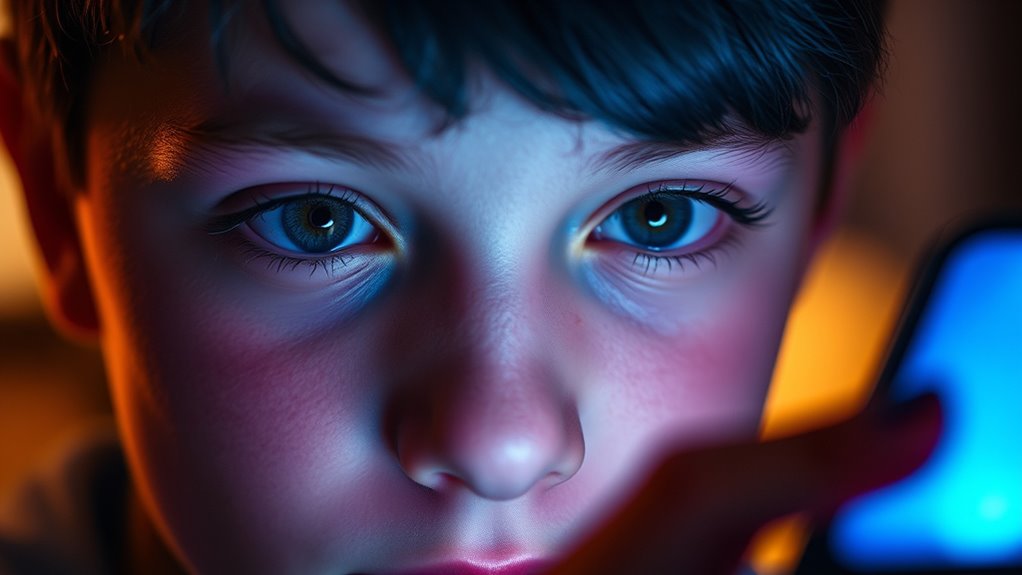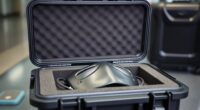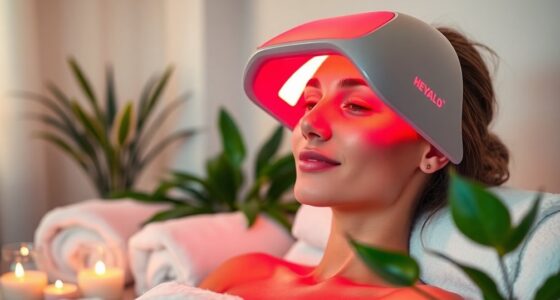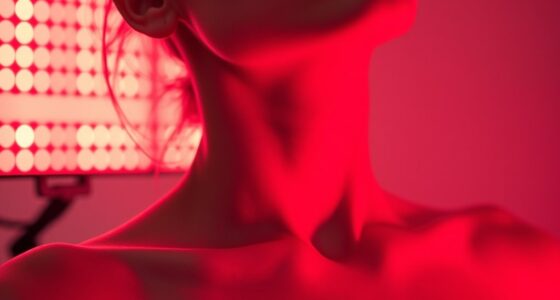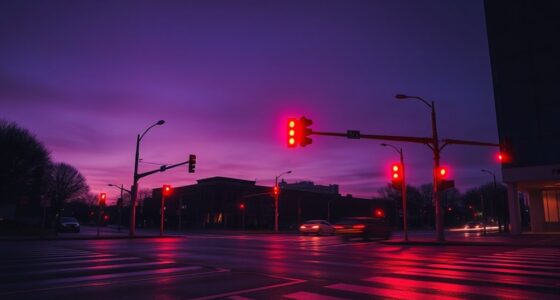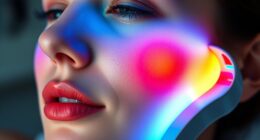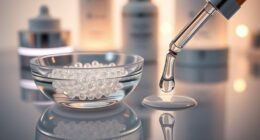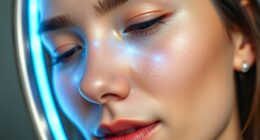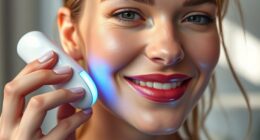To use blue light safely, limit screen time especially an hour before bed, and create a relaxing routine away from devices. Enable night mode or blue light filters on your screens, and wear blue light glasses if you need extended exposure. Keep screens at arm’s length and take regular breaks to rest your eyes. Balancing screen use with other activities helps protect your sleep and eye health. Discover more tips to stay healthy while staying connected.
Key Takeaways
- Limit screen time an hour before bed and create a relaxing bedtime routine.
- Use blue light filters or “night mode” on devices during evening hours.
- Wear blue light blocking glasses for extended screen use, especially at night.
- Take regular breaks, looking away every 20 minutes to reduce eye strain.
- Maintain proper device positioning and environment lighting to support eye and sleep health.
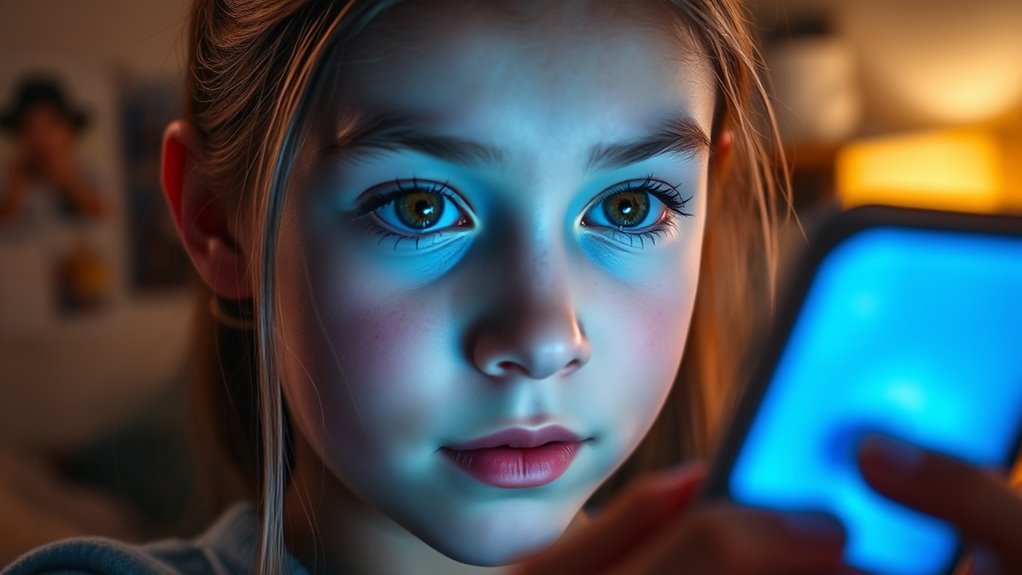
Have you ever wondered how blue light from screens affects teens? You’re probably aware that many teens spend hours each day glued to their smartphones, tablets, or computers. While these devices offer entertainment and learning opportunities, they also emit blue light, which can have significant effects on your health. Blue light is part of the visible light spectrum and is emitted in high amounts by LED screens. When you look at screens late into the evening, this exposure can interfere with your body’s natural sleep cycle. Blue light suppresses melatonin, the hormone responsible for helping you fall asleep, making it harder to drift off and reducing sleep quality. Over time, poor sleep can impact your mood, concentration, and overall well-being.
It’s important to understand how much blue light you’re exposed to and how to protect yourself. First, try to limit screen time, especially in the hour before bed. Establishing a routine where you put devices away at least 30 minutes to an hour before sleeping allows your body to produce enough melatonin. If you need to use screens later in the evening, consider enabling features like “night mode” or “blue light filters” on your devices. These settings reduce blue light emissions, making screens easier on your eyes and less disruptive to your sleep.
You should also be mindful of your environment. Use dim, warm-colored lighting in your room during the evening to create a relaxing atmosphere and further minimize blue light exposure. Taking regular breaks from screens is equally vital; every 20 minutes, look away from your device for at least 20 seconds to give your eyes a rest. This practice helps prevent eye strain and dryness caused by prolonged exposure to bright screens. Additionally, maintaining proper posture and keeping screens at an appropriate distance—about an arm’s length—can reduce eye fatigue. Limiting blue light exposure especially late at night can help improve sleep quality and overall health.
Investing in blue light blocking glasses is another option if you spend long hours in front of screens. These glasses have special coatings that filter out blue light, providing extra protection for your eyes, especially during late-night sessions. Remember, moderation is key. While blue light isn’t inherently harmful, excessive exposure, particularly late at night, can disrupt your sleep patterns and overall health. By being proactive—limiting screen time before bed, using protective settings, and taking regular eye breaks—you can enjoy the benefits of technology without compromising your well-being. Your eyes and sleep patterns will thank you, helping you stay healthier, more alert, and better rested.
Frequently Asked Questions
Can Blue Light Exposure Affect Teenage Eye Development?
Yes, blue light exposure can affect your teenage eye development. Prolonged exposure, especially from screens, may cause digital eye strain, discomfort, and potentially interfere with your sleep patterns. While research is ongoing, it’s wise to limit screen time, take regular breaks, and use blue light filters or glasses. These steps help protect your eyes and support healthy development during your teenage years.
Are There Any Long-Term Health Risks From Blue Light?
You might think blue light is harmless, but it could lead to serious long-term health risks, like major sleep disruptions or even eye damage over time. Constant exposure can mess with your circadian rhythm, making it harder to fall asleep and wake up refreshed. While more research is needed, it’s smart to limit screen time, use blue light filters, and give your eyes regular breaks to protect your health now and in the future.
How Much Blue Light Is Safe for Teens Daily?
You should limit blue light exposure to no more than 2 hours per day. Teens’ eyes are more sensitive, so it’s best to take regular breaks every 20 minutes when using screens. Using blue light filters or glasses can help reduce exposure. Prioritize outdoor activities and make sure screens are used in well-lit areas to protect your eye health and minimize potential risks.
Do Blue Light Glasses Really Protect Teens’ Eyes?
Think of blue light glasses like a shield protecting your eyes from harmful rays. They can reduce eye strain and block some blue light, but they aren’t a magic wand. While they help, you should still take breaks from screens and follow safe usage habits. So yes, blue light glasses do offer some protection, but combining them with good habits gives your eyes the best defense.
Can Blue Light Exposure Cause Sleep Problems in Teens?
Yes, blue light exposure can cause sleep problems in teens. When you spend a lot of time on screens, blue light suppresses melatonin, the hormone that helps you fall asleep. This can delay your sleep cycle, making it harder to fall asleep and reducing sleep quality. To protect your sleep, try limiting screen time before bed, use blue light filters, or wear blue light glasses as recommended.
Conclusion
Think of blue light as a double-edged sword—it can energize your mind or cast shadows on your sleep. By setting boundaries and taking breaks, you’re the captain steering your digital ship away from stormy seas. Remember, moderation is your lighthouse in the fog. Use blue light wisely, and you’ll keep your eyes bright and your nights peaceful, turning technology from a thief of rest into a trusted ally on your journey.
